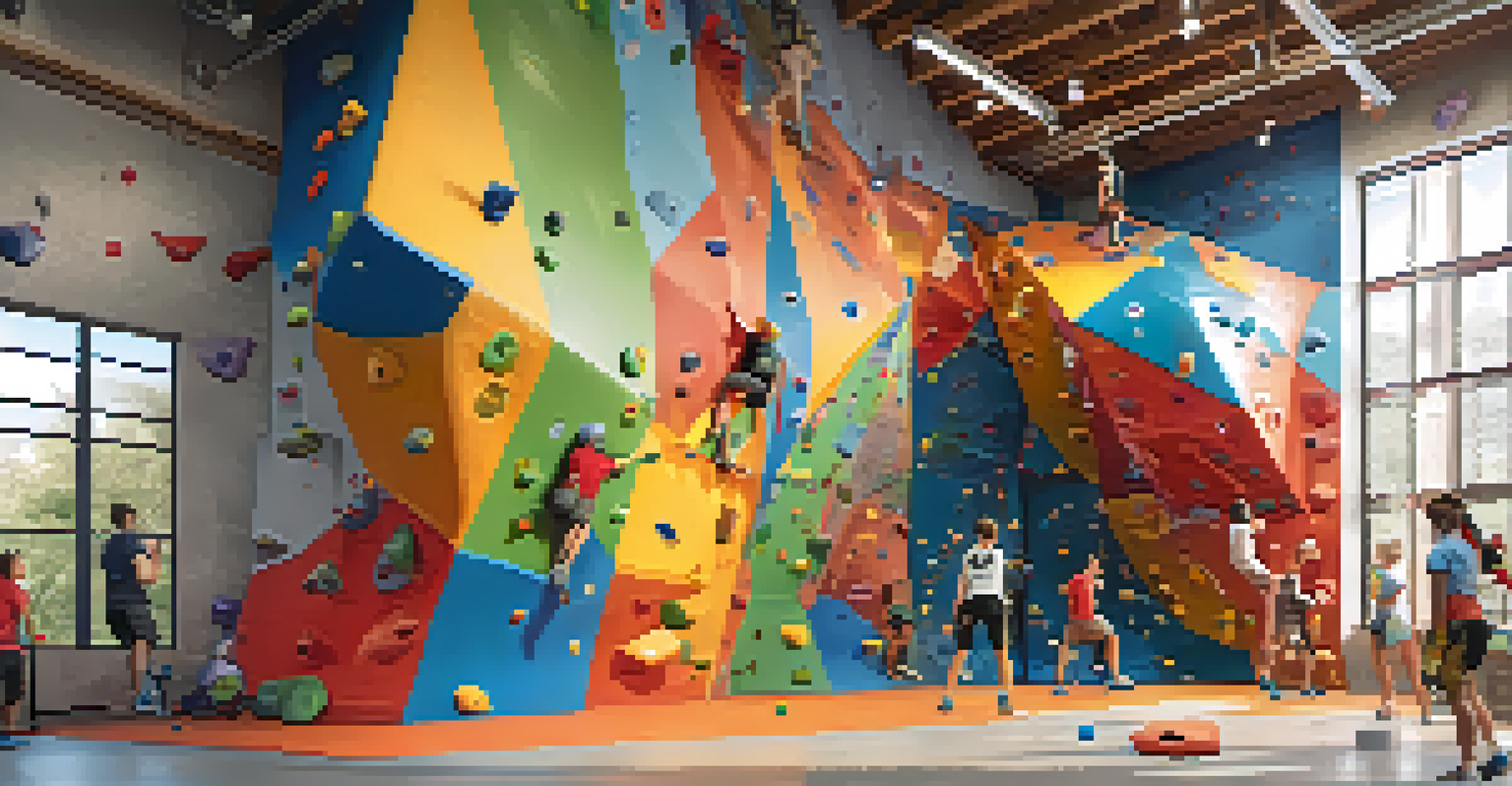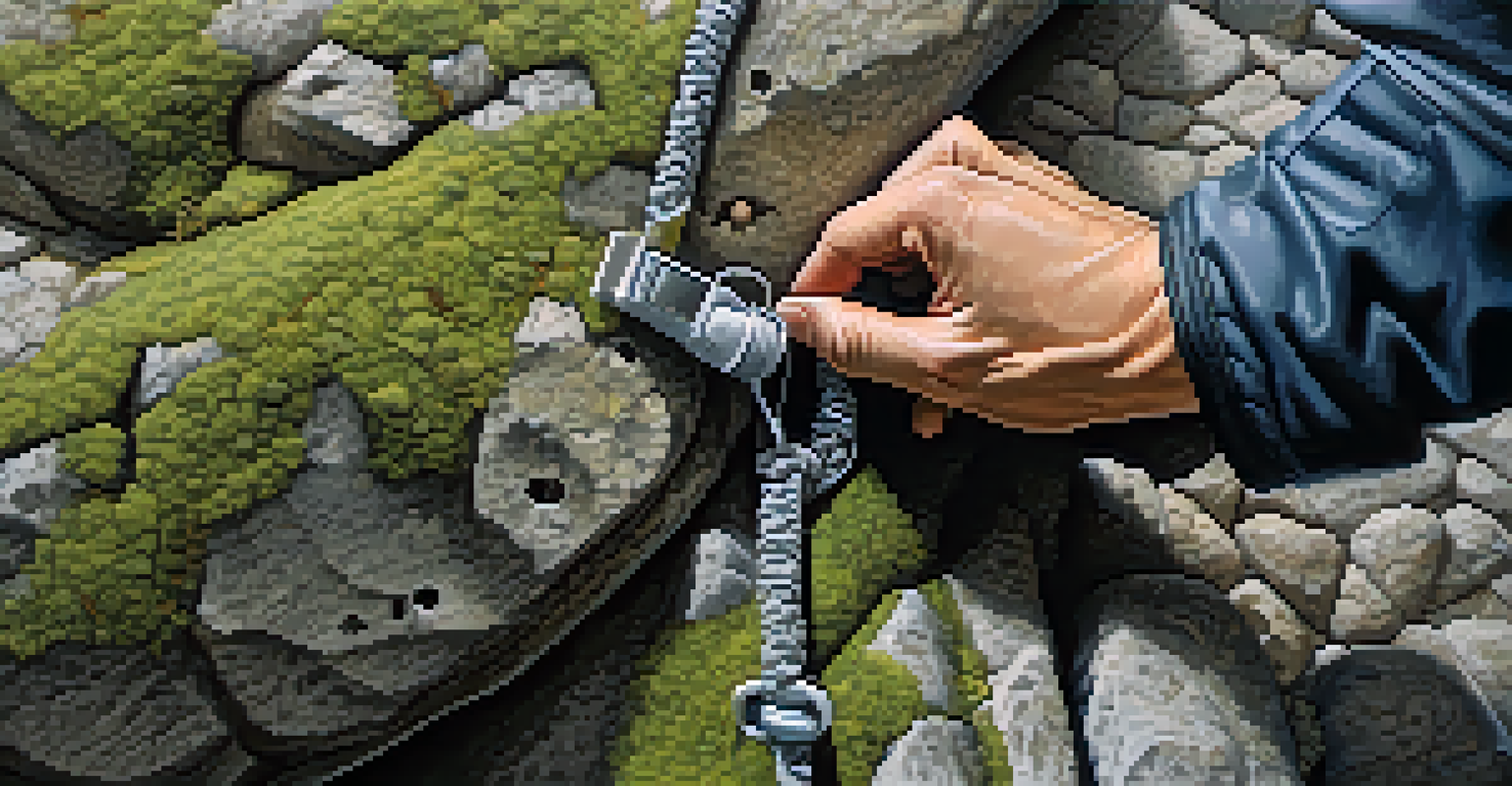Exploring the Different Styles of Rock Climbing: Trad vs. Sport

Understanding the Basics of Rock Climbing
Rock climbing is an exhilarating sport that challenges both the body and mind. At its core, it involves ascending natural rock formations or artificial rock walls. While the thrill is universal, the techniques and equipment can vary greatly, leading us to two popular styles: traditional (trad) climbing and sport climbing.
The best climber in the world is the one who's having the most fun.
Trad climbing emphasizes a more natural experience, allowing climbers to place their own protection as they ascend. This approach promotes a deep connection with the rock and the environment, often requiring a solid understanding of gear placement and climbing techniques. On the other hand, sport climbing offers a more straightforward experience with pre-placed anchors, making it accessible for climbers of various skill levels.
Both styles have unique challenges and rewards, appealing to different types of adventurers. Whether you’re drawn to the purity of trad climbing or the convenience of sport climbing, understanding these styles is essential for any climbing enthusiast.
Diving Deeper into Trad Climbing
Traditional climbing, or trad, is like a dance with nature, where climbers use removable gear like cams and nuts to protect their ascent. This method allows for a more flexible climbing route, as climbers can choose where to place their gear based on the rock's features. An essential part of trad climbing is the skill of gear placement and the ability to assess the rock for safety.

One of the beauties of trad climbing is the exploration aspect; climbers often venture into less-traveled areas, experiencing the great outdoors more intimately. However, this style requires a good understanding of rock formations and the necessary skills to navigate them safely. It's not uncommon for climbers to spend time learning from more experienced peers to gain confidence and proficiency.
Trad vs. Sport Climbing Explained
Understanding the key differences between traditional and sport climbing can help climbers choose the style that best suits their preferences and goals.
Trad climbing can also foster a strong sense of community among climbers who share tips and stories about their adventures. As climbers work together on multi-pitch routes or face challenging sections, they often forge lasting friendships. This camaraderie enhances the overall climbing experience, creating bonds that extend beyond the rock face.
The Appeal of Sport Climbing
Sport climbing is often viewed as more accessible due to its straightforward approach. With fixed anchors like bolts already in place, climbers can focus on their technique and strength without the added stress of gear placement. This structure allows climbers to push their limits and enjoy a more controlled climbing experience.
Climbing is not just about the summit; it's about the journey and the friendships formed along the way.
The routes in sport climbing are often marked, making it easier for climbers to gauge their progress and skill level. Many climbing gyms offer sport climbing walls, allowing beginners to practice in a safe environment before heading outdoors. This accessibility has contributed to the growing popularity of sport climbing around the world.
Additionally, sport climbing competitions have gained momentum, showcasing the impressive skills of climbers at all levels. These events not only inspire new climbers but also encourage seasoned athletes to refine their techniques and push boundaries. The combination of community support and competitive spirit makes sport climbing an exhilarating choice for many.
Gear Differences: Trad vs. Sport
When it comes to gear, there's a clear distinction between trad and sport climbing. Trad climbers rely on a variety of protective devices, including cams, nuts, and slings, which they place as they ascend. This gear is crucial for their safety and requires a good deal of knowledge and practice to use effectively.
In contrast, sport climbers typically use a harness and a rope, with quickdraws attached to pre-placed bolts along the route. This simplicity allows climbers to focus more on movement and less on gear management while climbing. However, sport climbers still need to understand how to belay properly and use their gear safely.
Safety is Crucial in Climbing
Both trad and sport climbing require a strong emphasis on safety, with unique challenges that climbers must navigate to enjoy the sport responsibly.
Understanding the gear differences not only enhances safety but also influences the overall climbing experience. Each style demands unique skills and knowledge, making it essential for climbers to choose the right equipment based on their preferred climbing method.
Safety Considerations in Trad and Sport Climbing
Safety is paramount in both trad and sport climbing, but the approaches can differ. In trad climbing, the responsibility for placing and assessing gear falls heavily on the climber, requiring them to be vigilant and knowledgeable about rock conditions. This self-reliance can be empowering but also means that climbers must be well-prepared for potential risks.
Sport climbing, while generally considered to be safer due to fixed anchors, comes with its own set of challenges. Climbers must still be cautious about their fall potential and ensure that their belayer is attentive and skilled. The dynamics of climbing, including factors like rope stretch and fall distance, play a crucial role in safety during sport climbs.
In both styles, education and experience are key. Taking climbing courses, learning from seasoned climbers, and practicing safety protocols can significantly reduce risks and enhance the climbing experience. Whether you choose trad or sport climbing, prioritizing safety is essential to enjoying the sport responsibly.
Which Style is Right for You?
Choosing between trad and sport climbing often comes down to personal preferences and goals. If you crave adventure and the thrill of exploring new routes while connecting with nature, trad climbing might be your ideal fit. It offers a unique sense of accomplishment and often leads to stunning outdoor experiences.
On the other hand, if you enjoy pushing your physical limits in a structured environment, sport climbing could be more your style. With the convenience of pre-placed anchors, you can focus on improving your skills and tackling challenging routes without the added complexity of gear placement.
Community Unites Climbers Worldwide
Regardless of climbing style, a vibrant community fosters connection and support among climbers, enhancing the overall climbing experience.
Ultimately, many climbers find joy in both styles, adapting their climbing experiences based on their mood, environment, and goals. Exploring both trad and sport climbing can enrich your skills and make you a well-rounded climber, ready for any adventure that comes your way.
The Community Aspect of Climbing
Regardless of whether you prefer trad or sport climbing, both styles boast vibrant and supportive communities. Climbing is often seen as more than just a sport; it's a lifestyle that brings like-minded individuals together. Whether you're sharing tips at the crag or cheering each other on during a competition, the sense of community is palpable.
Many climbing clubs and organizations host events, workshops, and social gatherings that cater to climbers of all levels. These opportunities foster friendships and allow climbers to learn from one another, regardless of their chosen style. The shared passion for climbing creates bonds that can last a lifetime.

Moreover, social media has played a significant role in connecting climbers globally. From sharing climbing achievements to seeking advice, platforms like Instagram and Facebook have made it easier than ever to find and engage with fellow climbing enthusiasts. This sense of belonging can enhance your climbing journey, making it even more enjoyable.